#awhalin
Explore tagged Tumblr posts
Text
I always talk about how one of my loves of scrimshaw is being able to see the art of Just Some Guy in the 19th c. and this is the latest one I’m charmed by.
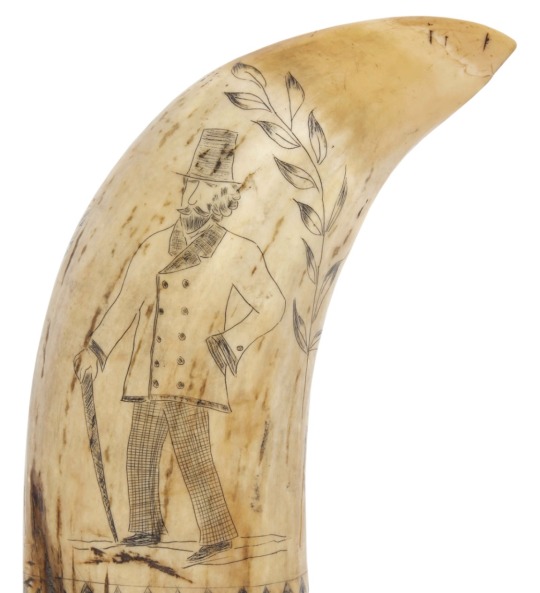
I love his face, look at how economical those lines are!
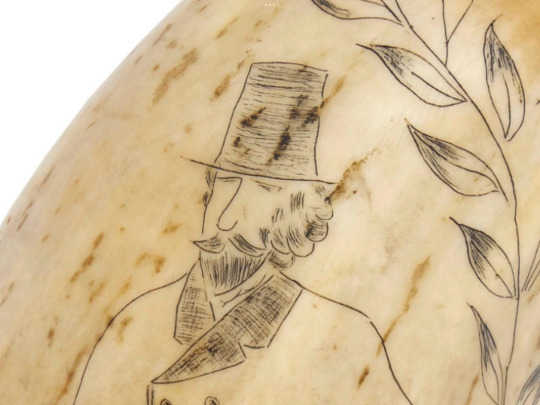
2K notes
·
View notes
Note
Thanks so much for sharing!
For anon’s curiosity, I’ll also link a more in-depth essay I wrote about whale craft, where I also say a bit more about whale lines. It’s here!
I’m reading Moby Dick right now, and I’m trying to understand Melville’s descriptions of the whaling lines they keep neatly coiled in the two (or one) large barrels. Could you shed some more light on this practice for me?
Hi, Yes I can. Although I have to say that I can explain it all to you individually now, but my friend @focsle made a wonderful post about it and so read this one, it is just perfect.
Just to let you know I'm not lazy but a good post deserves to be shared and my lungs are getting really nasty again and sending me to bed most of the day to rest. Wish you a lo of fun reading.
99 notes
·
View notes
Text


Lawrence Manner for @focsle !!!!
#going to weather#lawrence manner#art tag#why did i sit there for 40 seconds trying to remember the name of the comic#and my I kept going ‘awhalin’ ‘no’ ‘awhalin’ ‘that’s not it’
28 notes
·
View notes
Text
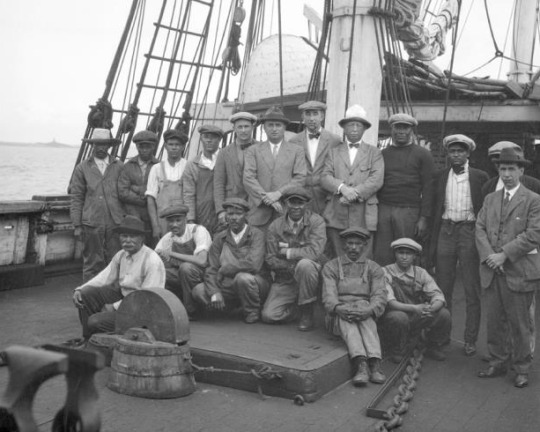

I'm so fond of these two 1924 photos taken by William Tripp of the crew of the whaling bark Wanderer because they were clearly taken in the same moment but the fellow in the front second from the right was like 'wait, the cat!'. Or, alternatively, he was holding the cat first and the cat was like 'I'm not sticking around for this'.
1K notes
·
View notes
Text

Man...they're so young. Every day I'm reminded how young the majority of whalers were.
1925, photographed by William Tripp
#this is 20th century so it was more common to see older men aboard#but at the peak of the industry most were under the age of 25#awhalin
321 notes
·
View notes
Text
Will my little awhalin webcomic have any chance against…an ancient epic poem.
⚓Boat Media Tournament⚓
Round 2, match 15


56 notes
·
View notes
Note
have you written anything about tattoos? is that relevant? don't know how your niche lines up with generic "sailor" tradition, but wikipedia simply says on knuckle tats that deckhands may get "HOLD / FAST" as a charm to support their grip on rigging, and i thought that was kind of cute.
I haven't written anything myself, mostly cos if you throw a stick out in the internet you'll find any number of articles about the symbolism of sailor tattoos, like hold fast and pigs and roosters and swallows and all that!
In my narrow window (the middle decades of the 19th century), I don't see tattoos mentioned all too often, compared to late 19th and throughout the 20th century where they became more common. For instance, this register of seaman's protection certificates (which are admittedly limited in the scope of things, since they're only from a few specific ports) from 1796-1871 rarely list tattoos as distinguishing marks, beyond the odd mention of being marked with an inked anchor, eagle, or letters here or there. Here's a neat jstor article (if you have any more of your 100 free monthly articles to read with a google account) that goes into late 18th-early 19th c tattoos that has some tables and visuals. The research was also done using seaman's protection certificates, with the following stat:
"The SPC-A records start in 1796 and include tattooed men born as early as 1746. There were 979 tattooed men out of a total of 9,772 men whose records survive from 1796 through 1818.26 These men were marked with a total of about 2,354 separate designs."
So, not a large number, but also 10% isn't insignificant. The protection certificates while a reliable source, also only describe the man in one specific moment. I'm sure a few of those men who just have their moles and scars and crooked fingers listed eventually picked up a tattoo or two in their time. Most journal keepers perhaps didn't think it important to mention who had tattoos or what of, though the typical motifs of anchors, nautical stars, girls, religious & patriotic imagery, etc. were certainly a part of the visual language at this point. Whaler William Abbe who sailed in the 1850s, devoted considerable attention to describing the physical appearance of some of his shipmates. In one instance, he wrote about the tattoos of one 'Johnny Come Lately' or 'Jack Marlinspike' (Real name, John Hewes of Buffalo NY)
'from beneath this cap his face looms out - while beneath supporting his comical head is a bare neck and breast — hairy + brown —the upper timbers to a stout hull of a boat that boast a pair of arms all covered with India ink tattooings — the figure of American Liberty — Christ on the cross — an American Tar holding a star spangled banner in one hand + a coil of rope in the other — a fancy girl — + anchors, rings, crosses, knots, stars all over his wrists + hands — the memorials of different ports he has visited — for Jack has been in all kinds of vessels from a man of war to a blubber hunter — + has consequently been to many ports.'
From the logbook of another whaler who sailed in the early 1840s, James Moore Ritchie, he had a page of his drawings with prices included. This potentially may have been a tattoo flash sheet for his shipmates:

American whalers also noted the tattoos of indigenous people who had signed on to whaling vessels, particularly in the South Pacific. William B. Whitecar, whaling in the 1850s wrote: "Several New Zealanders in the respective crews of these vessels attracted my attention from the tattooing on their bodies" making mention of "figures on their face and breast".
I'm too sleepy to have a conclusion lol. Tattoos! They existed! Though perhaps not as ubiquitously as the pop culture sailor designs would imply, at least prior to the late 19th c.
222 notes
·
View notes
Text
Something about this little note a whaler added in the margins of his journal gets me.
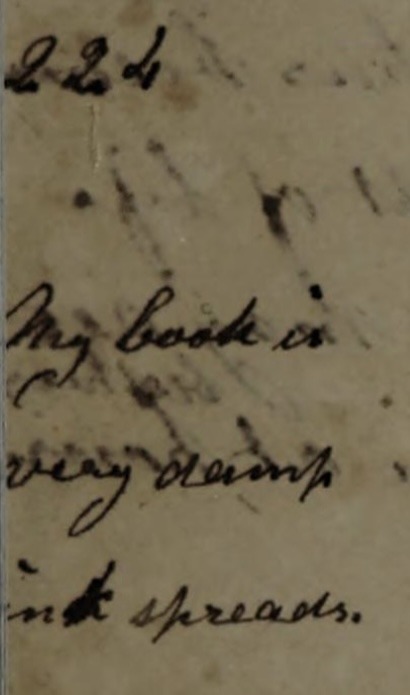
224 [days out] My book is very damp ink spreads.
Can’t really articulate why but I think it’s something about…the process of reading it now in all its spreading ink, and seeing this little complaint he penned in the moment to explain the ink quality. It‘s a concrete physical link to a little moment in time when this book was new (yet damp) in a fellow’s hands 170 years ago.
#cooper chappell#awhalin#all the bits in these journals where they’re basically like ‘OH I CAN’T WRITE ANYMORE GOT TO GO THERE’S WHALES’#or ‘i want to write more on this but I’m so tired I got 2 hours of sleep’#are the ones that get me the most because of that specific tie to a moment#and to a real person who u know…gets tired and hungry and what have you
276 notes
·
View notes
Text
Medicine Aboard A Whaler
I answered an ask about this some years back that was...a few paragraphs long and was before I learned that some people have the stamina and desire to read 3k+ word whaling essays from me. So if ye count yourself among them, here you go!
---
On August 21st, 1870 aboard the whaleship Sunbeam, two-time whaler Silliman Ives found himself ill with a condition “very akin to mumps, with the exception of the swelling”. It prevented him from opening his mouth, and he dreamed of the days when such an action was possible.
“I never really appreciated the luxury of a good gape before. When a fellow cannot open his mouth to any greater extent than the width of a lead pencil, gaping is not a success to say the least. And then anything in the way of a sneeze is entirely out of the question, unless you are prepared to part company with the top of your head at very short notice. A ship is a hard place to be unwell in. So long as one is in good health you can get along nicely. But if you are sick the only place where you can find sympathy is in the dictionary. And then too the remedies at hand are limited in number and obsolete in use. Your medicine chest is filled with medicines in use a hundred years ago, but which modern pharmacy has dispensed with to a very great extent. Calomel and castor oil and such like delectable doses. There is no question about it. A whale ship ought to have a surgeon, and the law should oblige such vessels to carry them. When I get into Congress I shall introduce a “Bill” to that effect.”
As Mr. Ives noted, American whaleships went without doctors aboard even when the work was rife with injury and illness, and often quite far from access to any kind of care ashore. On British whalers it was required by law for a surgeon to be signed on for the voyage—Sir Arthur Conan Doyle was one on a voyage bound for the Arctic and apparently fell in the water so many times that the crew called him the 'Great Northern Diver'. However on American whalers—which dominated the industry—a doctor was seen by the agents as an unnecessary expense. There was the captain, the carpenter, and folks who could mend sails. Together, that makes one whole doctor! Right?
Read on, to see how they fared.
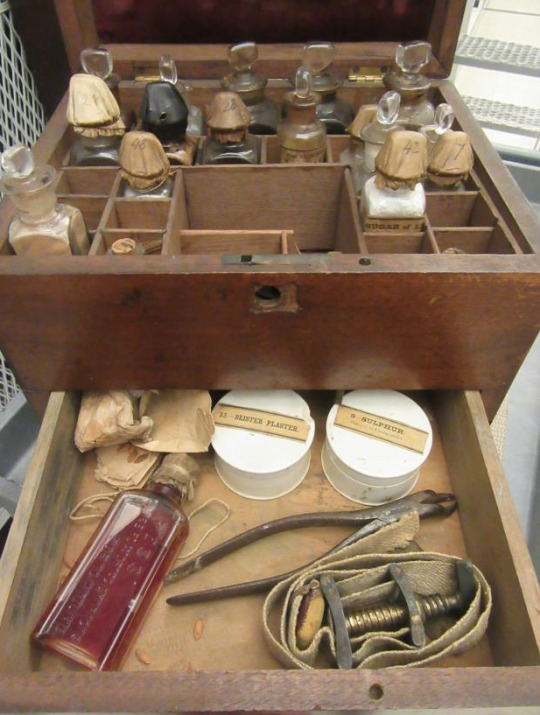
1845 whaleship medicine chest from the collection of the New Bedford Whaling Museum.
Joan Druett, in her book Rough Medicine highlighted some really fascinating things that came as a result of this, ranging from men who had scars that healed in a herringbone pattern because they were mended like canvas, to this wild tale about an amputation performed between a captain and mate at gunpoint:
“Another stirring tale told is of a Captain Coffin, who was hurt so badly in a whaling accident that it was obvious his leg would have to go. Being the master, the medic, and the patient all at once, he knew the situation was complicated, but he was more than equal to the task. He sent for his pistol and a knife, saying to his mate, “Now, sir, you gotta lop off this here leg, and if you flinch—well, sir, you get shot in the head.” Then he sat as steady as a rock while the mate went at it with the knife, holding the pistol unwaveringly until the operation was completed. No sooner was the stump wrapped up and the leg cast overboard than both men fainted.”
It was the captain's responsibility to provide medical treatment. Often without training himself, he was simply given a medicine chest full of numbered tinctures for various treatments. Those tinctures were a mix of chemical and herbal compounds, some which are still used holistically today and some that you.....absolutely want nowhere near your body. Epsom salts as a laxative, laudanum for painkiller, St John's wort for bruises and burns, mercury for syphilis, rosemary as an antiseptic, lead acetate as an anti-inflammatory, arrowroot for dysentery, henbane for insomnia, and on it goes from the innocuous to the dangerous.
John B King was a rare doctor aboard a whaleship, sailing on the Aurora out of Nantucket in 1837. He wasn’t hired as a doctor though; for reasons unknown he initially obscured his identity and joined simply as a foremasthand until his skills were revealed and he became the ship’s doctor. On that voyage he kept a book of the medicines he used.
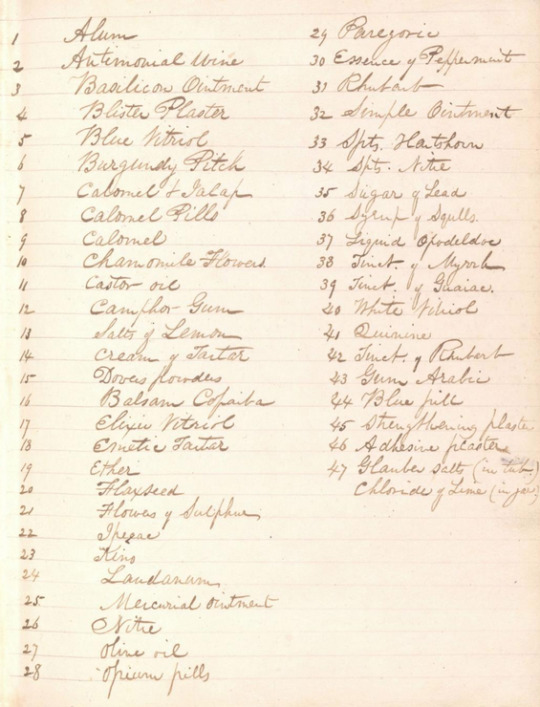
John King’s medicine list, from the collections of the Nantucket Historical Association.
In addition to dosing medicine, the captain would also be responsible for setting broken bones, stitching wounds, and amputations. Benjamin Boodry, who had been whaling since the age of 13 and by 1856 was captain of the Fanny described instances in which he had to tend to his crew.
“At 2 o clock a cask of watter rooled away in the Bluber room and one John Haggerty tryed to stop it and got his leg broke just above the Nee there was another chance to show my surgical skill set it splinted it and bandaged it.” “McKee fel from the Main Topsail yard on deck bled him in both arms he came to some broke his arm and leg and badly bruised”.
Fortunately for McKee, his accident happened off the coast of Faial. The captain sent for a doctor ashore to examine him. He was advised to leave McKee in the Azores where he could receive more proper rest and treatment. But if land was a long way off, people had to make do the best they could.
Some captains had a better bedside manner than others. Where Silliman Ives felt terribly neglected in his illness, William Abbe of the Atkins Adams, 1859, had quite a different experience. He turned to the captain for help with a painful swelling on his hand that eventually grew so bad he was unable to use it.
“The captain was extremely tender in his treatment of my hand, pouring on laudanum to relieve the pain, lancing with caution and as tenderly as could he and using every means in his power to make me comfortable—washing my hand thrice a day with warm water and cutting away dead skin, pressing out matter in a manner that gained my affection + respect. Mrs. Wilson sent me preserved meats, pickled oysters, cake, buttered bread and seconded her husband in all his care. I felt a great deal of respect for both these kind people + shall repay it when I can […] The Cap treated us all with a care + skill that surprised me — I supposed that we should be left to take care of ourselves—the case in many ships, but we were not only cared for but allowed to stay below until we thought fit to return to duty.”
Mrs. Wilson--the captain’s wife--stepping up to help was not so unusual. Often whaling wives also found themselves taking on the role of doctor. All throughout July 1846, Mary Brewster was busy tending to the ailments of the crew aboard the Tiger.
“The last part of the day I have spent in making doses for the sick, in dressing some hands and feet, 5 sick and I am sent to for all the medicin. I am willing to do what can be done for any one particularly if sick for in whaling season a whaleship is a hard place for comfort for well ones and much more sick men.”
She reported that all her patients recovered, with the exception of a young man with a liver complaint beyond her immediate treatment.
Other times, other members of the crew served as de facto doctors as well. One such man was veteran whaler John Martin aboard the Lucy Ann 1842. In addition to being a skilled watercolorist, he also had a knack for bloodletting and tooth pulling. Often he made note of his ministrations in his journal:
“Blistered Frank on the side for his pleurisy & the steward on the neck for the sore throat” “Cupped the steward on the back of his neck with wine glasses and lanced with razor for want of proper instruments, which gave him almost instant relief” “Pulled a large jaw tooth for one of the crew. I lanced the gum with a penknife & set him spouting thick blood, & at the second wrench of the iron turned it up.” [Very cheeky language he’s using here, the same sort of talk one uses when hunting whales] “The loose whale struck Mr. Dean on the lower jaw & broke it, & knocked out 2 of his lower teeth, & he was taken on board [...] Sat up with Mr. Dean last night [...] Bled Mr. Dean [...] Drew 3 teeth from Mr. Deans broken jaw.” “Bled Antone. Since the death of Manuel, Antone has been on the sick list with swelled testicles and pain in his back. Poor fellow, he is very much frightened & thinks he is going to follow Manuel. He occupies the same bunk. When I bled him, he was so frightened that the perspiration stood on him in large drops, & groaned like a person dying.” “Blistered and glystered [clystered, i.e. gave an enema] Antone.”

One of John Martin’s watercolors from his journal. NBWM.
Blistering, bleeding, and emetics were among the most common treatments for all that ailed a man aboard. John King included his recipe for creating a blistering plaster and its uses:
“Blisters are serviceable in affections of the chest attended with much pain and difficulty of breathing. Bleeding or purging is proper previous to the application. Severe and long-continued headaches are relieved by a blister to the back of the neck. In all cases before applying a blister, the part should be washed with warm vinegar and wiped dry. The plaster should be spread as thick as a wafer on soft leather. When laid aside it soon becomes mouldy in the dampness of a ship, but if rubbed over with a knife the same one will draw two or three times. When very old it loses its strength. From eight to twelve hours is the time usually required for drawing a blister. Then remove it and dress with basilicon or simple ointment”
—
Other ailments were met with more specific treatments. It was not uncommon to see logbooks noting several men laid low on account of ‘the venereal’. William Chappell, a cooper and boatsteerer aboard the Saratoga in the early 1850s commented on the frequency the mate found himself off duty following liberty ashore.
“Our mate is off duty again with that disgracefull disease and as near as I can find out it threatens destruction to a small but very usefull member of the body I am sorry for him but he is old enough to know better than to play with every body that looks pretty and bewitching”
“Flaxseed tea is very serviceable in clap”, wrote John King in his journal, as well as white vitriol “sometimes used as an injection in protracted cases of clap.” For syphilis, the common treatments were more severe. King writes,
“No 25. Mercurial Ointment This is frequently used in venereal cases for bringing the system under the influence of mercury. The bulk of a small nutmeg is rubbed on the inside of the thighs morning and evening until the gums are slightly sore. It is a good application to chancres when mixed with twice the quantity of lard, and renewed twice a day.”
Mercury compounds could also be injected into the urethra. There were doctors who spoke out about the use of mercury in treating syphilis contemporary to when use was at its height. One 1853 advertisement in the New Bedford newspaper the Whaleman’s Shipping List reads,

“Important to the Afflicted CONFIDENTIAL TREATMENT in Medicine and Surgery may be had of Dr. TOMPKINS at his office in rear of the Apothecary’s Shop, No 58 Middle, corner of North Second St Dr. TOMPKINS gives particular attention to the treatment and cure of private diseases. All those who have been taking medicines of their own prescribing, or from certain inexperienced or self-styled physicians, for a long time without benefit, are respectfully invited to call on Dr Tompkins, who is a regularly educated Physician of twenty years experience, and is competent to treat diseases of all kinds, and in every stage and form. Dr. T. warns the public against the abuse of mercurials; he is convinced by long experience, that most of the chronic affections, generally supposed to be the relics of diseases, are merely the effects of a long continued course of mercury. Recent affections cured in a very short time, without a grain of mercury”
Even with such objections, mercury compounds still were the standard and did more to sicken their patients than cure them. While whalers were often listed as being off duty due to venereal disease, there was less comment about whether or not they were given anything to attempt to alleviate it compared to other conditions.
“Our mate limping about again—had another furious attact of the venereal He is a used up man I fear,” Mr. Chappell wrote. Ultimately the mate was in a poor enough condition that he left the voyage at the next provision stop they made.
—
Scurvy was another common affliction. Given that whaleships spent extended time at sea and were loathe to waste too much time with anchoring somewhere, fresh food ran low quite often. When whaling in the Atlantic and South Pacific whalers usually fared okay, as there were a fair number of provision stops in locations that had fresh fruits and vegetables readily available for trade. It was on said provision stops that whalers could also, as said by Samuel Wood of the Bowditch, 1849, take a walk to 'knock the scurvey from their bones’. In seasons that took place up north however, in the North Pacific, Sea of Okhotsk (Kamchatka Sea), Bering Strait, and eventually up into the Arctic, scurvy was extremely prevalent. The fresh food depleted, the ice was always a threat, and unlike other regions there weren't many accessible places to resupply with large amounts of foods that could ward off scurvy. It's in reading journals during these periods that I find the most complaints of scurvy. And sometimes, the more successful the voyage was, the sicker the men would get because they'd spend more time up there rather than giving up and returning south. The US Consul in Hawaii complained of this in the 1840s, saying:
"Whaleships were much more successful in taking oil on the North West during the last summer and fall than for three or four seasons previous and most of the vessels remained on the fishing grounds much longer than usual, the consequence of which was that many of the crews were severely afflicted with scurvy, some died after reaching port and before they could be landed, while others were carried to the hospital on litters, being too feeble to walk."
There were endless attempts to ward it off. John Martin wrote of men "In the evening, dancing cotillions and jumping the rope to keep off the scurvey". It didn't seem to do much. Within two weeks:
"One man on the sick list, supposed to be caused by his being so long at sea. All hands are complaining of soreness throughout their bodies. If we do not get on shore soon, we may expect to have half the crew down with the scurvey at least. We have no vegetables on board, and are going into King Georges Sound, New Holland [southwest tip of Australia], a place where we can scarcely get anything to recruit with."
His captain allowed the crew unlimited vinegar and free access to the potato pen. The vinegar, a mistaken remedy due to its acidity, wouldn't have helped much. Potatoes are an excellent source of vitamin C, more so when they're raw, but they were rather intolerable to eat in such a way.
William Chappell spoke of a similar struggle with potatoes, and the grim humor the lads maintained to choke them down:
“Three of our men are off duty with the scurvy which makes its appearance in the knees and feet All hands are called aft every morning to get 2 or 3 potatoes apies which they are required to eat raw in the preasance of the officers for fear they may throw them overboard as many require presing invitation to partake of the dainties They have however a considerable sport over them Call them Kodiak Peaches”\
Aside from the crunch of Kodiak Peaches, Dr. King had his own remedy for scurvy as well:
“13. Salts of Lemon This is good in scurvy when fresh fruit and vegetables can not be obtained. A teaspoonful dissolved in half a pint of water will form an acid nearly the strength of lime juice. It may be mixed with water and taken freely, sweetened or not. [it makes a good substitute for lemonade, in fever, to allay thirst in fever] Water made slightly acidic with it is a good substitute for lemonade to allay thirst in fever."

The Sailor’s Hospital in Lahaina, Maui, constructed in the early 1830s.
For all the varying attempts to hold off sickness, it took root among crews nearly every voyage. J.E. Haviland of the Baltic, in the early 1850s spent the last few dozen pages of his journal in a state of declining health and low spirits.
“My side and breast pain me nearly all times I have not been on deck since I came below. The Captain and Mr Stivers are both very kind and come down to see me as often as once a day and sometimes two or 3 times. I am taking medicine but it does not seem to do much good but I think I am better than I was at first. Dear mother how I do wish I could see you once more. I get so homesick and I know I am peevish and cross. Some days I cannot get out of my bunk at all. I blame the captain (wrongfully I know) thinking he does not give me the right medicine but it is a very bad place to be sick at sea.”
He suspected it was due to the harsh conditions of whaling up North, but also held a fear within him that it might be something more serious that couldn’t be remedied simply by warmer climes.
“Dear mother, I shall be obliged to leave the ship when we arive at the Sanwich Islands for I do not think I could live doing another season in the cold Norwest. My cough seems to increase and the pain in my side gets no better I am getting weaker each day and am getting very thin in flesh. I have said nothing as yet to the old man about my leaving at the island as I do not know as he will be willing that I should; but I intend going to a doctor and in all probability will tell the old man I am not fit to go North in the ship […] I would like very much to be in the states now for I am afraid this will turn out to be the Consumption that I have. I think if I could have good medical advice I might get rid of it before it got seated upon my lungs. I am afraid it will be a long before I shall see my native land again.”
Ultimately Haviland is discharged from the ship because of his sickness and is left at the Sailor’s Hospital in Lahaina. His stay seems to do him well. His last entry reads:
“I have been here now going on two months and am entirely free from my cough and think I feel as well as ever again. It is intensely hot and I am heartily sick of the place and sincerely wish I could get away but I do not expect any chance before next fall.”
Unfortunately from here he completely drops off the record, so it’s unknown if he ever made it back home. Like so many of these men, he slips through the cracks of documented history. It’s only through their journals, preserved by chance, that their voices and challenges and feelings are known. Often a whaling voyage marked at least one death due to disease or injury. But many also recovered, sometimes rather miraculously given the circumstances and extent of their ailments. In the face of the conditions of a whaler and the limitations of care both in terms of resources and medical understandings at the time, I’m always surprised that there wasn’t more death. People did what they could, with the knowledge they had.
But as so many people expressed while laid up in their bunks: it’s a hard time to be sick at sea.
#some of these things are repurposed from other asks#im still so surprised more people didn't die...#awhalin#haviland makes me sooo sad...and I didn't even include the bits that made me saddest...
150 notes
·
View notes
Text
Sure thing! I remember being so surprised at HOW much light they brought into a space, when I first saw them in action.

[ID: photo of closely clustered ship bunks, lit by an overhead prism. /end ID]
The yellow light is artificial but the blue is from the deck prism, on a cloudy day.
nautical history friends help
there’s a glass thing aboard wooden whaling ships where it’s like a little crystal they put in the ceiling to let light in belowdecks
what the fuck is it called
it looks kind of like this


???
49K notes
·
View notes
Text
William Chappell mentioned ‘scrimshonting’ on his voyage but I didn’t know an attributed work of his survives in the New Bedford Whaling Museum’s collections! Here’s a lazy-susan-esque object designed to hold daguerreotype that he made on this 1850s voyage I’m currently going through…
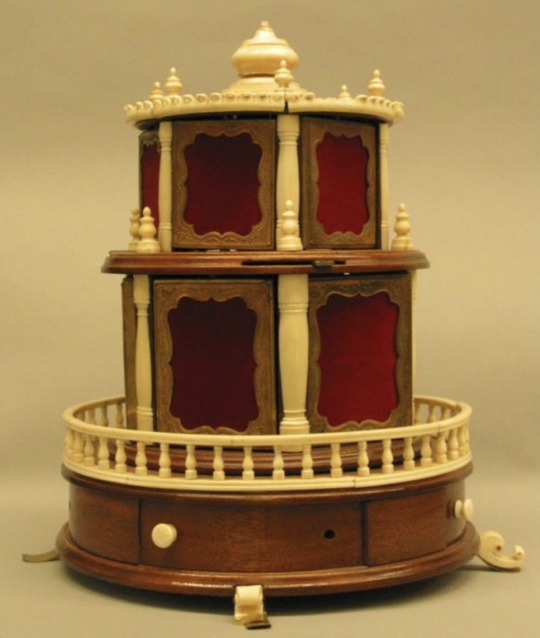
162 notes
·
View notes
Note
I've seen you answer a few asks about whaling history before, so hopefully I'm not offbase asking you questions out of the blue? But anyway, how did people bathe (or keep clean if not by bathing) during long sea voyages?
Not off base at all! Out of the blue whaling history questions are some of my fav asks to receive; I find them thrilling. I can’t help but write an essay every time.
It was particularly hard to keep clean on a whaler, and whalemen were often disparaged by those in other maritime professions. In 1839, naval Lieutenant Charles Wilkes said of the crew of the whaleship America,
“I have seldom seen at sea a more uncombed and dirty set of mariners than his crew.“
J.E. Haviland of the Baltic, 1856, complained of besmirching his journal pages with the grime that he was unable to scrub off his hands after tarring the rigging, self consciously saying:
“My hands + clothes would look beautiful for a ladies Parlor. I see they even collor the paper but I cannot get the tar out. The Old Man says he intends to have me tar down the rigging a few days before we get in New Bedford so that I shall not forget too soon that I have been a sailor.”
General ships’ work such as tarring could be messy, but a whaler’s work was even messier. When trying out blubber it was futile to attempt maintaining any semblance of cleanliness during the process. William Abbe of the Atkins Adams, 1859, said that during boiling, a watch would turn in to their bunks a few hours rest, merely ‘after wiping off your bare body with oakum to take off the thickest of the oil”.
But the gore and oil wasn’t forever. After the particular job was done the ship would be meticulously cleaned, and the whalers would tend to themselves too. As Herman Melville wrote,
“The crew themselves proceed to their own ablutions; shift themselves from top to toe; and finally issue to the immaculate deck, fresh and all aglow, as bridegrooms new-leaped from out the daintiest Holland. Now, with elated step, they pace the planks in twos and threes, and humorously discourse of parlors, sofas, carpets, and fine cambrics; propose to mat the deck; think of having hanging to the top; object not to taking tea by moonlight on the piazza of the forecastle. To hint to such musked mariners of oil, and bone, and blubber, were little short of audacity. They know not the thing you distantly allude to. Away, and bring us napkins!”
Haviland expressed gratitude in getting a chance to get clean after all the work of boiling blubber was done:
“I feel much better to day I have given myself a good wash + a clean shave + got in all clean clothes. You would not have known your own son if you could have seen him yesterday. I was nearly black with smoke + dirt. (with shame) I say it was the accumulation of 2 months dirt + 4 months beard. Everything looks as clean + bright as it did before we took the whale”
Being able to bathe was such a highlight that Abbe titled one of his journal pages “Washing myself!!” With TWO exclamation points!
“I write with pride in my fastidious journal that this morning I washed my face + hands with castile soap + fresh water — when shall I do the like again? When shall I write the pleasant and comfortable fact that I have shaved? The future and fair weather only can tell.”
The ship’s slop chest—its general store—had toiletries for sale, often at a very high premium. Whaling account books show men buying pounds of oil soap for their own personal stores. The fresh water was often rainwater collected for this purpose, rather than the casks set aside for drinking.
“This has been a rather squally day,” wrote Mary Lawrence, whaling wife who accompanied her husband on his ship Addison in the 1850s. “Considerable rain has fallen, and everybody on deck is using an abundant supply of rainwater for washing purposes.” She also added, though this is speaking of laundry rather than bathing, “Having stopped up the scuppers, the use the whole deck for one grand washtub.”
They’d use the sea, too. John Martin of the Lucy Ann, wrote of bathing via rain and sea whilst near the equator on January 24th, 1842.
“Towards noon the rain came down in torrents. The weather being sultry the watch on deck shipped off their shirts to it. John the boat steerer went entirely naked with the exception of a handkerchief tied around his privates. In the afternoon it cleared away, when I asked permission from the Captain for the crew to take a bathe over the side. He said we might do it if we rigged a studding sail over the side, which was soon done & all hands that could swim were to be seen jumping from different parts of the ship. Some went out to the end of the flying jib boom & jumped off there. Even the dog was thrown overboard & got his share of washing. I like bathing at sea but for one thing, and that is sharks. I always have a fear that one might be hovering about and give one a nip before he was aware of it.”
It was challenging for whalers to keep clean by nature of the job, but man when they were able to they really seemed to revel in it. For many of them it was more than just a bath; it was a symbolic return to a home they were long away from, or to the man they perceived themselves to be back on shore, or of a society that they felt cut off from in their line of work.
If you’re interested I also wrote a thing about doing laundry on whaleships too, yonder!
149 notes
·
View notes
Note
what's the best way to serve whale?
am hungee
Can’t attest—I have not eaten whale.
Muktuk is a traditional Inuit food. It’s skin and blubber usually from bowheads (but also beluga and narwhal) that’s diced small and often eaten raw. It can also be prepared in other ways like frying or pickling. Very high in Vitamin D & C.
Turning to my 19th c. American whalers, it being my schtick and all, they tended to not be particularly interested in eating whale. Nor were whales hunted for meat. But sometimes the odd recipe comes out here and there. John Martin, whaler on the Lucy Ann, 1840s talked about ‘roasting the top of a whale’s head’ that they were otherwise processing.
“The top of a right whale’s head is covered with barnacles & small crabs. When roasted they are good eating. They also take part of his lip and render it out in the hot oil. When eaten with pepper & vinegar it tastes very much like soused tripe.”
Mary Lawrence, whaling wife on the Addison, 1850s also mentioned eating whale up North:
“We have been eating bowhead meat for several days, made with pork into sausage cakes, also fried, and it is really good eating, far before salt pork in my estimation.”
J.E. Haviland, greenhand on the Baltic 1850s shared a similar recipe for porpoise, which is similar enough.
“We had it for Breakfast this morning. The way it is prepared at sea is to take + hash it up very fine seasoned with sage pepper + salt and then made in small balls + fried or baked in pork + I can say from experience it is proper good.”
William Tripp, boatsteerer on the John R. Manta, 1920s,
“The meat was cooked as steaks, while some was ground and made into 'whalemeat balls.' It was eaten by all hands and much relished as the first frest meat since leaving port."
John Ross Browne, writer on an unnamed whaler in the 1840s, talked about snacks whilst trying out. In addition to frying saltwater-soaked sea biscuits and celebratory donuts in the whale oil, sometimes whalers would eat the leftover ‘cracklings’, i.e. crispy bits of whale skin left over after the process, as well as:
“Sometimes, when on friendly terms with the steward, they make fritters of the brains of the whale mixed with flour, and cook them in the oil. These are considered a most sumptuous delicacy. Certain portions of the whale's flesh are also eaten with relish, though, to my thinking, not a very great luxury, being coarse and strong. Mixed with potatoes, however, like " porpoise balls," they answer very well for variety. A good appetite makes almost any kind of food palatable. I have eaten whale-flesh at sea with as much relish as I ever ate roast-beef ashore.”
Not everyone’s into it, though. When John Langdon and other crew members aboard the St. Peter, 1840s, came to air grievances about the captain expecting them to be content with eating spoiled beef, the captain,
“rowse[d] up a little telling us how he had lived on whale and blackfish meat for a time on the Nor’west; but this would not go down with us and we demanded state’s allowance. He saw we were in good earnest so after while concluded to give us good beef.”
And lastly, from Moby-Dick, Stubb’s preferred method of cooking whale steak which he berated the cook with:
“Hold the steak in one hand, and show a live coal to it with the other; that done, dish it; d’ye hear?”
#people can expect that if they send a silly ask I will still answer with Primary Sources and a narrative arc.#asks#anonymous#awhalin
95 notes
·
View notes
Text
Alternatively, here’s the itemized outfit and financial woes of my friend William, who did not have $220, in 1856:

Transcript: An outfit for 35.06 - 4 lb Tobacco - 1.00 - 1 Sh Knife - .28 - 1 pair shoes - 1.88 - 1 belt + Shi[h][?] .25 - 1 spoon .08 - 1 pair drawers - 1.10 - 1 undershirt - 1.10 - 1 pair socks - .80 - 2 lb Tobac . 50 (more William?) - Sick [?] Tale + Liberty [?] Money - 8 - Buy 1 pair shoes - 1.13

“There is one thing for the want of which I suffer books a book to read. Owing to my shipping in a my being obliged to ship myself get my chest and outfit sign the articles, have a protection taken out for me, select my chest and entire outfit, write four letters, eat my dinner and get aboard all in the span of 2 hours and a half it may be supposed that I had not much time to buy books even if I had had the money and twenty cents I am sorry to say was all I had left out of several dollars with which I landed in New Bedford three days before.”

Bless the keeper of this 1860s whaling logbook for including an itemized list of what he considers to be ‘a good outfit’.
Transcript:
A Good Outfit A good long coat - 12.00 A pea jacket - 5.00 A good oil suit - 6.00 2 good pair of boots - 12.00 4 pair of pumps thick and thin - 8.00 6 thick woolen shirts - 18.00 6 under shirts - 12.00 6 pair of drawers all wool - 12.00 6 pair of stockings - 6.00 3 pair of mittens - 1.50 1 comfitter [sic] - 1.50 6 cotton shirts - 12.00 3 hats - 5.00 3 caps - 3.00 4 pair woolen pants - 20.00 4 pair cotton pants - 12.00 4 jumpers - 8.00 1 box of soap - 1.50 A [?] knives, sheath knife, and belt - 4.00 1 quadrant and bowditch navigator - 20.00 Nautical almanac for the [?] [voyage?] - 2.00 1 suit of shore clothes 1 set of scrimtion [sic] tools 1 pair of glasses - 12.00 The kedge anchor -2.00 pipes and mathes [sic] - 1.50 sail sewing utensails [sic] - 1.00 1 marlin spike - 1.00 some painkillers and sulpler [sic] and balsam of life and other medicines 1 closeline [sic] 221.00
216 notes
·
View notes
Text
Went thru another one of Mr. Keith’s journals, this one from 1866-69 when he’s second mate (later first) on the whale ship Cape Horn Pigeon. Every journal entry is addressed to his wife (who was also on his mind on other voyages prior to his marrying her). The thought of her dominates the pages more than anything else, and is a very personal insight into the mind of a man who chose to make the sea his living, for all its distance.

“All day on deck today and have been as homesick as a dog all day. To Night I have got all night to sleep in. I have been fitting the Main Top Gallant brace blocks on the mizzen took down the double ones And put up single ones. Last Night I was dreaming of you I woke up Some time in the night and kissed your picture and went to sleep Again and went to dreaming again of you. This is all I can say to you To night in this book but I am going to write some in your letter. So thousands of sweet kisses to you darling Sarah Good Night.”
More entries under the cut for length.
He was homesick and lovesick often, thinking his shipmates wouldn’t understand.
“There has been a lot of ships in sight to day all of them with the exception of One was bound to England and she was going to America and Oh Sarah Darling how I thought of you. How I wish I was on board of her Bound to see my lovly Companion. I could have cryed but these hard Hearted sailors who have no wives and home would laugh at me.”
Every aspect of his daily life reflected back to how she was faring, from being thankful she didn’t have to drink the ship’s stagnant water, to how he entertained himself and others on deck.
“This forenoon was very unpleasant for it rained until Twelve O clock and I did not change my clothes until after dinner I got wet through by being out in the rain washing my clothes. This Afternoon has been pleasant and my men have been getting out Fresh water to drink and such water, Sarah I am glad you do not have to drink it. I have got all night to sleep in. I have just come down from the deck where I have been playing the Accordion and thinking of you. I always feel sadest when I Sing or play. Darling girl a pleasant night to you dream dear Girl of your Marshall who at the time you dream will be thinking of you Sweet one I must say again Good Night Sarah Dear.”
He often made note of his dreams that swung between the erotic, the homesick, and the anxious, and often a mix of the three. Here was one about getting caught with a Different Sarah.
“This has been a nice day Sarah not a breath of air Stirring I have been on deck all day and felt some better than I did yesterday but far from being well. I have set up the Head rigging to day. Last night I dreampt I was at home and in some strange house standing in the door way you came Out and passed me. I asked you where you were going. You Said after water. After you left me Sarah Munroe came Up to me and asked me if I wanted to see some thing. I told her yes. She open her dress in front and showed Me her bubies she asked me if they looked pretty I told her yes. I asked her to let me feel of them. She said yes. I asked her to let me kiss them she said yes but don’t let Sarah Pope see you just as I was in the act you came in sight and caught me and Oh what a blessing you gave me. Sarah I will tell you more bye and bye. I must Close by saying many kisses to you Good Night Darling Wife.”
For whatever other women were in his mind during the voyage, he made a point to mention that the dreams turned back to her.
“Had a quear dream a regular sailors dream which is always About the women. delacacy prompts me from writing the Most of it but the last of it was about you. I met you and you asked me where I was going I told you to the barbers to shave all of. I thought you kissed me and asked me not to shave off my mostash. I told you I would not But you said it was twelve O clock and I had better go to bed I said all right you know I never refused to go to bed with you in my life. I must say Good Night Darling Sarah.”
Sometimes the dreams were influenced by anxieties met in life. When he didn’t receive an expected letter from her (which hardly reflects on whether or not she wrote him—receiving letters aboard vessels was a long and uncertain process), he had a dream mixed with both his doubt of her life ashore but also his hopes.
“This has been a nice day Sarah and I have been to work very hard but that did not take my mind up so but what I felt bad on account of not getting a letter from you. You will not neglect me again so will you Sarah. Last night I dreampt I got home and I Came into the kitchen and saw your mother (and my Mother) sitting there by herself. I asked her where Sarah was She said you were in your room taking care of the Baby. I asked her whose baby it was. She said it was mine. Then I came in and saw you sitting down with a pretty Little cherub in your lap and it looked so good to me I asked you whose it was you said it belongs to me. And out of a joke I told you it never was mine. When you came up to me and cryed and kissed me and said it belonged to me. So Sarah after you have slighted me you see you have a space in my dreams of pleasure still.”
Eventually he did receive word from her, and learned that his dream proved true.
“This has been a pleasant day Sarah and This morning when I got up that island was in sight what Held your letters for me. At Twelve O Clock the capt went on Shore and at 5 he came of and had Two letters for me. One from you and one from Aurelia. The one from you was No 1. Sarah I must bid you pleasant dreams with your little baby for it was tonight I first learned that you were going to have one.”
In addition to homesickness, he often mentioned physical sickness, usually pains in his side. His health issues and day dreaming led to friction with the captain.
“It has been a nice day today but I have been sick all day and this noon. I could not eat my dinner and I stopped on deck while the rest got their dinner. I sat close to the door on a chest and I heard the old curse say there is a man on board this ship that wishes himself At home I wish he was there. When he came up I pitched up to him and I gave him enough of it. What is more he could not stop me. Last night I was very sick in the night and I wanted to make water. I had a bottle in my bearth and did not feel like going on deck so I used it for that Purpose and this morning I forgot to throw it over board. This fore noon the Old Hog went into my room to look for some Screws and he saw the bottle he smelt of it and Accused me of taking something to make me sick. Oh Sarah that most killed me. I have cryed all the afternoon just on that account. And he went as far as to tell me I hold my Wife too well he said he thought you were in my mind most of the time and that I wanted to see you so much that I was making my self sick to get home. And what do you think I called him. A god damned fool and a liar.
At one point he seems to consider his sickness to be pregnancy sympathy pains.
“This has been a pleasant day Sarah but I have been feeling very bad bordering onto sickness and a very bad pain in my side but I do not think it strange as you are about to have a child. I think I have been sick enough over one child. Oh Sarah Darling how I do and have pitied you for my suffering has been nothing compared with yours but I hope on this pleasant day they are all over. And I hope you will not have an other one while I go to sea. I must bid you good night my dearest angel Good Night.”
His dreams now often featured the baby as well, and again was a mix of hope and anxiety.
“Oh if I could see my Wife to night I would not feel as I do now but that is impossible. Last night I drempt I was at home and met you in the street and kissed you and I thought you kissed me but you done it in such a way I thought you did not care much about me, for you kissed me quick and turned away from me. I asked you what you had named it (the Baby) and you told me its name was Hannah Rachel Keith. Then you said to me I hope you like the name. I thought I was with you until bed time and we started to go to bed and just as we were going into the bed room I woke up and found myself on board the Cape Horn Pigeon a long way from my darling Sarah. Sarah kiss Hannah Rachel for me and I will bid you both good night.
He later learns from a letter that the baby was named Susie Rachel. When whales were captured, he always thought of them in terms of dresses for his wife and things for his baby.
“It has blown most a gale to day Sarah and I have been to the Mast head seven hours where the wind could Blow through me. But it was not for pleasure that I done it. It was to look for whales that we might catch them what I could earn something for my wife and child but could not see any thing. And the wind has blown my eyes almost out of my head. But I feel that was done for a good cause Sarah. I can not say much to night but nevertheless I love you as Fondly as before and shall continue to do so as long as we are permitted to live. Darling Sarah kiss that sweet babe for me and I must bid good night to those who alone I ask to live for. Ten thousand kisses to you Sweet Sarah.”
At one instance he wrote, ‘I am wet through with oil Sarah at the presant time But I know you would not disown me if you saw me now.’ It was his life, and it was through that life that he saw his ability to provide for a family, however distant they may be. In this frame of mind, one more to close:

“We are boiling our whales Sarah and I am covered with oil but it makes the money come and it is all for you. I could live in oil for your sake. I must close and go on deck until 1 O clock at night. Kiss my babe for me. Good night Sarah.”
29 notes
·
View notes
Text

“And all in a hurry to leave but the Captn has not finished his wonderful business”
In which the cooper Mr. Chappell expresses frustration over how long the ship always delays in port because the Captain’s too busy Fuckin.

We have taken our anchors at last and we are now lying off and are waiting the moves of the Captn. He does not like to leave his bedfellows. Some of us are wicked enough to believe he has one. Such things are too fashionable in these ports and the female portion of the community are very forward but I have escaped without being insulted by them and though many of them are pretty yet they have no charms for me. I shall soon be home where I shall not try to keep clear of the Ladies for they were made to be loved and I am bound to love all the virtuous ones but only one in particular. She is 32 years old today. I have thought much of her today though I have not been able to celebrate her birthday
The following day the captain sends a letter to the mate saying he’ll be ready to leave the next day for sure. When the next day passes, however,

“Night has returned and we are still Lying off and on. We have looked hard for the Captn today but I presume he has many reasonable [underlined] excuses. If we could contrive a plan to get the women out of the place his business would soon be closed. I think I shall have many better reasons for staying in port if I ever get into the port of New Bedford.”
97 notes
·
View notes